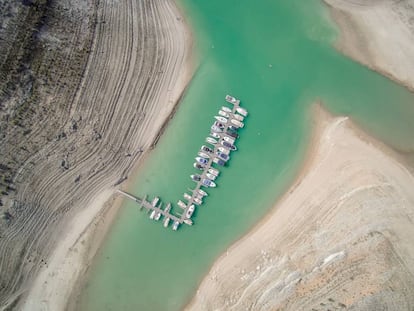The spectacular flowering of Chile’s Atacama Desert
Unusual winter rains lead to display involving more than 200 species of native plants
The botanist Gina Arancio walks carefully among the flowers as she announces their exotic names with enthusiasm: Virgin’s tears, the Paw of the Guanaco, Lion’s Claws, the Monk’s Crown, Fox Ears, Devil’s Tobacco. We are on the edges of the Atacama Desert, north of the city of La Serena, in Chile.
This is one of the most arid places on the planet, a place more similar to Mars than the rest of Earth, but today it looks like a colorful carpet. Arancio calls it “magic.”
More than 200 native plant species were hidden for years under gray soil, waiting for a few drops of water
“In a normal year, this whole place, the entire environment, including hills, slopes, and plains is gray. There is no greenery, no flowers. Absolutely nothing,” says the researcher with the University of La Serena. “But as soon as a little bit of rain falls, this marvel appears,” she says, pointing out everything around her.
It is the flowering desert, a natural spectacle that occurs every five or 10 years due to the unpredictable phenomenon of El Niño, which warms the waters of the eastern Pacific Ocean. The evaporation of these warm currents on the coasts of Chile causes abundant rain in the Atacama Desert, which triggers the germination and flowering of more than 200 native plant species that have been hidden for years under gray soil, waiting for a few drops of water.
The flowering of the desert – currently enjoying its peak moment – is the most spectacular of the last 20 years. The flowering, according to Arancio, triggers a chain reaction. After the flowers come the insects that pollinate them. And with the insects come reptiles, birds and rodents, which are food for the foxes. And, above all, the majestic guanaco stands out – a wild camelid related to the llama that is native to the region.
There are large projects planned that threaten these unique plants
“The flowering desert phenomenon has occurred for at least a few millennia,” says paleoclimatologist Antonio Maldonado, of the Center for Advanced Studies in Arid Zones (CEAZA) in La Serena. Some Chilean and international media have linked the intensity of this year with global warming, but Maldonado is skeptical. “There is nothing concrete establishing a relationship between climate change and this flowering desert, beyond the expectation of extreme weather to come, such as torrential rain,” he says.
The flowering of 1997 was, according to the scientist, more spectacular than this year’s event.
The botanist Gina Arancio runs a herbarium with thousands of Chilean species. Many of them are native to the Atacama Desert. They are here and nowhere else. “More protected areas are needed in the region,” she says. There are big projects planned which threaten these unique plants. “When the companies – whether they are mining, tourist or thermoelectric – carry out their environmental impact studies, they do during a times with no precipitation. Therefore, they can declare that these are inhospitable areas with few plants. However, they do not take into account everything under the ground: that huge bank of seeds that lies dormant. And they totally destroy it.”
English version by Debora Almeida.









































